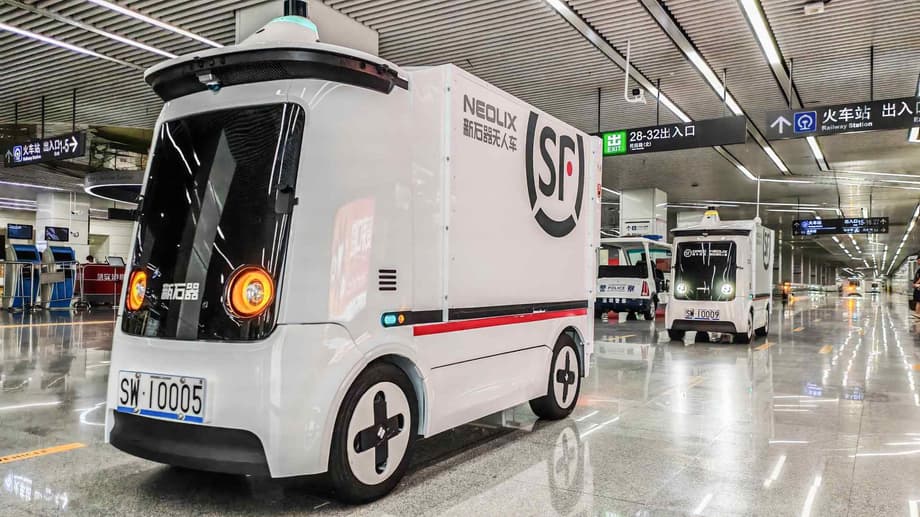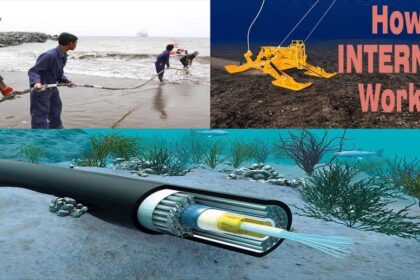After Hours in Shenzhen, Driverless Vans Take Over
When evening crowds thin at Shenzhen’s Futian railway station, a new shift begins. Boxy autonomous vans roll from a storage area and shuttle to a drop point near the platforms. They follow mapped routes, speak through onboard speakers to ask pedestrians to keep a two meter distance, and halt when someone steps in front of them. The routine is calm and deliberate. It looks like a small scene, yet it captures a big story. China has moved automated delivery from demo days to daily work.
- After Hours in Shenzhen, Driverless Vans Take Over
- Why China Leads the Robovan Race
- Inside the Technology: From Level 4 Autonomy to Cloud Control
- From Pandemic Experiments to Everyday Logistics
- Business Case and Cost Pressures
- Rules, Permits, and Safety in the Real World
- Competition Heats Up at Home and Abroad
- What Robovans Can and Cannot Do Today
- Key Points
These robots do not roam everywhere. They operate on designated roads, link depots to collection points, and slot into tightly managed logistics flows. Couriers load parcels into lockers or cabinets at a depot. The vans carry the load to a station curb or neighborhood hub. People pick up from a staffed counter or an automated cabinet. The process cuts idling time for drivers and reduces repeated short trips. It is a model designed for dense cities where volumes are high and minutes matter.
Why China Leads the Robovan Race
China’s advance rests on three reinforcing strengths. First is policy. City governments have carved out pilot zones for intelligent connected vehicles, set rules for safety and data reporting, and issued permits that allow driverless testing within a clear operational design domain. That creates predictable conditions for companies to invest and iterate. Second is demand. E commerce giants and delivery networks move billions of parcels a year, and every efficiency gain scales. Third is supply. Domestic makers of sensors, electric drivetrains, and control software can build and refine systems quickly and at cost levels that support commercial trials.
Industry programs are growing across many provinces. Dozens of cities have approved high capacity autonomous delivery vans on public roads. Cainiao, the logistics arm of Alibaba, has moved from research to mass production of driverless delivery vehicles. Company leaders say that more than 200,000 unmanned vehicles could enter logistics fleets over the next three to five years if current progress holds. The direction is clear. Automated logistics is shifting from one off pilots to networked operations in select corridors and districts.
Inside the Technology: From Level 4 Autonomy to Cloud Control
Today’s robovans target Level 4 automation. That means the vehicle can drive itself without human input within a defined set of areas and conditions. The system hands control to a remote operator only when a situation falls outside that design envelope. The goal is continuity of service on repeatable routes, not full citywide autonomy.
Sensors and perception
Modern delivery vans fuse lidar, radar, and cameras to see in 360 degrees. Redundant sensor suites identify vehicles, traffic lights, pedestrians, cyclists, and road edges. WeRide’s Robovan W5 is a current example of this architecture. The W5 is built for around the clock service, offers the largest cargo volume in its class at 5.5 cubic meters, carries up to 1,000 kilograms, and can travel up to 220 kilometers per charge. The company says the system draws on nearly 1,900 days of field operations and almost 40 million kilometers of autonomous driving on public roads. The software plans routes, overtakes when safe, avoids obstacles, docks at loading bays, and adjusts paths to steer around congestion.
Redundancy is a core safety tactic. The W5 uses a drive by wire chassis with backup actuation, paired with overlapping perception and emergency braking. The aim is to ensure that a single component failure does not compromise control. Continuous self checks report the driving state to the cloud and flag anomalies for human review.
Fleet operations and platooning
Autonomy is only part of the product. Fleet software is the other. Operators schedule tasks, monitor vehicles in real time, and push over the air updates. The system can group vehicles in a convoy so that one supervisor can manage several vans at once. That model helps scale service without adding headcount at the same rate as vehicles. Cloud based analytics also study delivery patterns. If parcel density rises in a district, the platform can pre position vans to match demand and cut turnaround time at depots.
From Pandemic Experiments to Everyday Logistics
Contactless delivery during the coronavirus outbreak gave the sector an early boost. Beijing based Neolix reported a spike in orders in early 2020 as retailers and food delivery platforms sought to reduce person to person contact. Customers included Alibaba, Meituan, and JD.com. That wave of pilots helped teams refine remote operations, maintenance routines, and loading workflows.
Once the immediate crisis passed, the most effective elements stayed. Companies that cut their teeth on robotaxis applied the same perception and planning stacks to goods movement. WeRide, for instance, expanded from robotaxis into self driving buses and logistics. Delivery proved attractive because routes are repeatable, speeds are modest, and service can run late at night when roads are less crowded. Those conditions play to the strengths of current autonomy while limiting exposure to the most complex city scenarios.
Business Case and Cost Pressures
The pitch is simple. If vans run longer hours with fewer staff and use electricity instead of diesel, cost per parcel drops. Cainiao executives have said that self driving vehicles could trim one to five Chinese cents from delivery costs per package in the right operating setup. Savings come from continuous operations, fewer short idle periods, tighter route planning, and better depot turnarounds.
There are real costs on the other side of the ledger. High grade sensors, compute units, and electric chassis add up. Downtime for maintenance and repairs needs careful planning to protect fleet utilization. Depots must be reconfigured to speed loading, charging, and handoffs. The model works best where parcel density is high, routes are consistent, and curb access is predictable. In scattered suburban settings with frequent one off stops, human couriers still offer flexibility that robots cannot match.
Profitability depends on density, duty cycle, and asset life. If a van can complete a large number of short hops each shift, charge during low demand periods, and run for several years without major overhauls, the return profile improves. Companies are betting that software improvements will also raise throughput without increasing hardware cost, further tilting the math in favor of automation.
Rules, Permits, and Safety in the Real World
Permits are the gatekeepers for expansion. In Guangzhou, WeRide’s Robovan W5 received approval to test driverless logistics vehicles in the Nansha District in April, then secured the first such permit in Huangpu District in July 2025. The approvals followed local policies to accelerate intelligent connected and new energy vehicles across mobility, sanitation, and smart logistics. These steps show how city by city regulatory progress is translating into wider service areas for autonomous delivery.
Safety practices are visible on the street. Vans move at low to moderate speed. They announce their presence with audio prompts, stop when people cross in front, and run on roads that have been mapped in detail. Remote operators watch for irregular events and can assist when a route is blocked or a signal is unclear. Insurance policies, incident reporting, and data logging are part of the package. The combination of geofencing, redundancy, and oversight aims to reduce risk as miles accumulate.
China’s approach contrasts with some Western markets where permits can be fragmented and public road testing faces tighter constraints. Logistics vehicles that carry goods instead of people often encounter a smoother regulatory path. Moving parcels between controlled depots and fixed pickup points is easier to certify than carrying passengers door to door.
Competition Heats Up at Home and Abroad
Partnerships are central to commercialization. WeRide works with Jiangling Motors on manufacturing and with ZTO Express on deployment. The plan is to build purpose designed delivery vans at scale and roll them into large logistics networks. Cainiao’s facility in Hangzhou’s Yuhang district already uses a fleet of more than 20 unmanned vehicles. Each has a loading capacity around five cubic meters and, according to the company, can move at least 1,500 packages per day. Those vans handle more than 30 percent of the depot’s parcels, a sign that when routes and volumes fit, autonomous service can take on meaningful share.
Outside China, interest is rising. Tesla revealed a concept Robovan, positioning it as a multi use people and cargo carrier. The name overlaps with WeRide’s model, and there is historical usage by Starship Technologies for a support van that carries sidewalk robots. Naming aside, the hard problems are similar for everyone: robust perception in complex traffic, safe behavior near pedestrians, smooth integration with depots, and economics that beat a driver and a van for the same job.
Other Chinese players in autonomous driving also see opportunity in logistics. Robotaxi programs have built up data, software, and operations teams that can shift to delivery routes. The companies that master reliable service, regulatory compliance, and cost control are likely to capture contracts from express delivery firms and city partners.
What Robovans Can and Cannot Do Today
These vehicles excel in specific patterns. They thrive on repeatable loops, high package density, and late night service when streets are clearer. Linking depots to stations, neighborhood hubs, or university campuses is a natural fit. Vans can stage outside residential complexes and notify recipients to pick up during a time window. The setup reduces idle cruising and keeps load factors high.
Limits remain. Most vans do not have robotic arms, so human staff load and unload at depots and hubs. Complex doorstep delivery to every apartment in a tall building is still better served by people. Heavy rain, construction detours, or large crowds can delay or reroute vehicles. Speed is capped for safety. Operators plan buffers into schedules to absorb those variables.
City infrastructure can make or break performance. Charging needs must be woven into depot schedules. Curb space at stations and neighborhoods is essential, along with clear signage so pedestrians know how to interact with the vehicles. High quality digital maps require constant updates. Reliable wireless links support monitoring and data transfer. Where cities align these pieces, robovans can deliver steady gains in service speed and predictability.
Key Points
- Autonomous delivery vans now run daily at sites like Shenzhen’s Futian station, operating on mapped routes with audio safety prompts and automatic stops for pedestrians.
- China’s lead comes from supportive city permits, massive parcel volumes, and a domestic supply base for sensors, software, and electric drivetrains.
- Cainiao projects that more than 200,000 unmanned delivery vehicles could enter service in the next three to five years as programs scale.
- WeRide’s Robovan W5 targets Level 4 autonomy, carries up to 1,000 kilograms, offers 5.5 cubic meters of cargo space, and can travel up to 220 kilometers per charge.
- Fleet platforms enable multi vehicle supervision, real time monitoring, route optimization, and over the air updates to improve utilization and safety.
- Cost per parcel can fall by one to five Chinese cents in the right settings, but hardware expense and depot integration still weigh on profitability.
- Regulatory progress includes new driverless logistics permits in Guangzhou’s Nansha and Huangpu districts, supporting wider city testing.
- Competition is active, with WeRide partnering on manufacturing and deployment, Cainiao expanding fleets, and Western firms exploring similar concepts.
- Robovans excel on repeatable, high density routes but still rely on human loading and face limits in complex doorstep delivery.












